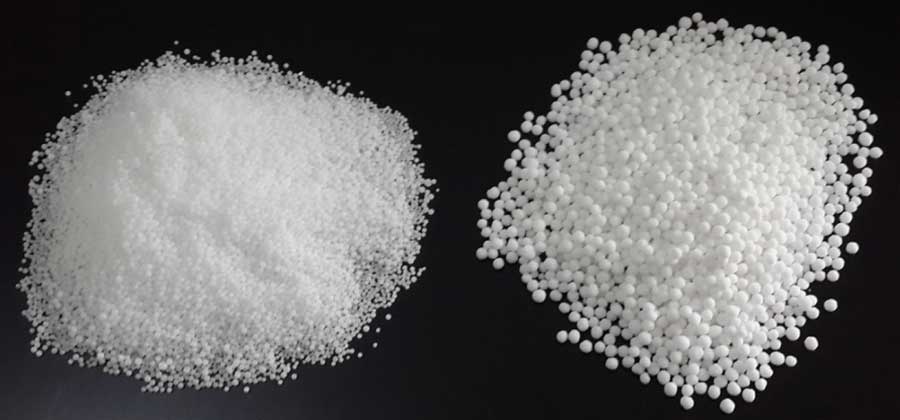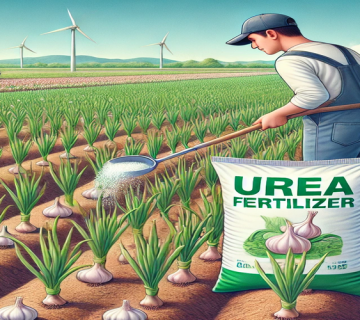In recent years, organic sources such as poultry manure, animal manure, and composted agricultural waste were commonly used to meet the nitrogen needs of agriculture. Over time, a mineral substance called urea was developed. Interestingly, urea has been labeled as the most suitable and economical nitrogen source, often referred to as nitrogen fertilizer. Stay with us to learn about the differences between prilled and granular urea fertilizer.
Be aware that prilled and granular urea are used in agriculture and various industries. This article aims to introduce you to the differences between prilled and granular urea. First, it is better to understand these two types before discussing their differences.
Learn More About Urea Fertilizer
Urea, with the chemical formula NH₂CONH₂, is one of the nitrogen fertilizers. The ratio of nitrogen, phosphorus, and potassium in this fertilizer, known as NPK, is 0-0-46. It is also called sugar fertilizer because of its white and pearl-like granules. Interestingly, urea is naturally produced in the bodies of humans and animals.
However, synthetic urea is also manufactured using anhydrous ammonia. Urea fertilizer is not expensive and provides farmers with the highest amount of nitrogen. However, certain precautions must be taken when using this fertilizer in soil to prevent nitrogen loss through chemical reactions.
Urea contains 46% nitrogen, which tends to have high losses in hot climates and alkaline soils. To minimize waste, we recommend using it in multiple applications.
Compared to ammonium nitrate, the losses of urea and ammonium nitrate fertilizers are high, so it is advised to apply them in portions.
This fertilizer is available in fine and coarse forms in the market. Given the leaching and volatilization of nitrogen, it is better to use granulated forms with larger dimensions, as they perform better than fine fertilizers.
Urea fertilizers dissolve well in water and are easily absorbed by plant leaves and roots. Nitrogen can be applied through soil application and foliar spraying to fruit trees. These fertilizers are typically applied to fruit trees two or three times as soil applications.
Uses and Applications of Urea Fertilizer
Urea fertilizer is one of the most common and widely used nitrogen fertilizers in the market. It is extensively utilized in various fields, including agriculture and industry. Interestingly, about 90% of global urea production is dedicated to agriculture, with the remaining 10% used in industrial applications. Many companies in Iran produce prilled urea and granular urea fertilizers.
Advantages of Urea Fertilizer
The benefits of urea fertilizer include:
- It can be stored for a long time without significant fire risk.
- Urea acidifies the soil, making it suitable for plants that grow better in acidic soils.
- Urea provides the maximum amount of nitrogen to the soil at a low cost.
- It can be used alone or mixed with other fertilizers.
- Urea is highly effective for crops like strawberries, corn, and other plants requiring high nitrogen levels.
Disadvantages of Urea Fertilizer
- Chemical reactions occur when urea is applied to soil, requiring special care to prevent ammonia volatilization. Without this care, farmers may face challenges.
- Due to urea’s high solubility, it must be stored in dry conditions.
What is the Difference Between Prilled and Granular Urea Fertilizer?
Urea fertilizer is available in two forms: granular and prilled, with the main difference being their size. The grain size of granular urea is typically between 2 and 4 millimeters, while prilled urea is between 1 and 2.4 millimeters.
Granular fertilizer has smaller, harder grains than prilled urea, which has narrower grains. Both fertilizers are extensively used in agriculture as rich nitrogen sources. They are widely available in the market and are cost-effective for farmers.
Note that both prilled and granular urea contain 46% nitrogen. However, their granule sizes vary depending on the manufacturer.
Price of Prilled and Granular Urea Fertilizer
This article introduced the differences between prilled and granular urea, their applications, and their uses. You can purchase the desired product from reputable companies. For any questions regarding prilled urea from Shiraz, you can contact PETROBNX’s sales team for guidance and consultation.





No comment